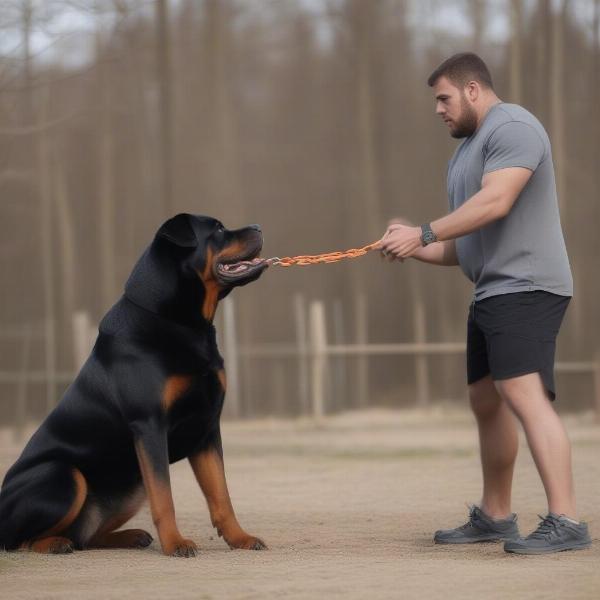Manly dogs often capture our attention with their imposing presence and confident demeanor. But what exactly constitutes a “manly dog”? It’s more than just size and muscle; it’s a combination of physical attributes, temperament, and even historical roles. This guide delves into the characteristics of breeds often perceived as manly, discussing their care, training, and suitability for different lifestyles. We’ll explore everything from powerful guardians to loyal companions, helping you find the perfect four-legged friend to match your personality and needs.
Defining “Manly” in the Canine World
What makes a dog “manly” is subjective and often based on cultural perceptions. Generally, breeds considered manly possess traits like strength, size, protective instincts, loyalty, and a stoic demeanor. Think of breeds like Rottweilers, German Shepherds, and Doberman Pinschers – these dogs often project an aura of power and self-assuredness. However, “manliness” can also encompass traits like courage, resilience, and a strong work ethic, found in breeds like Siberian Huskies and Alaskan Malamutes.
Breeds Often Considered Manly
Several breeds consistently make the “manly dog” list. Rottweilers, with their muscular build and protective instincts, are often seen as guardians. German Shepherds, known for their intelligence and versatility, excel in various roles, including police and military work. Doberman Pinschers, with their sleek appearance and alertness, are often employed as guard dogs. Other breeds, like Boxers, Great Danes, and Cane Corsos, also project an image of strength and confidence. Beyond these larger breeds, certain smaller breeds like the Staffordshire Bull Terrier, despite their size, possess a tenacious spirit and muscular physique that some perceive as manly.
Care and Training for Manly Dogs
While these breeds may share a perceived “manliness,” their individual care and training needs vary. Large breeds require ample space and regular exercise to maintain their physical and mental well-being. Early socialization and consistent training are crucial, especially for breeds with strong protective instincts, to ensure they develop into well-adjusted companions.
 A man training a large breed dog with obedience commands.
A man training a large breed dog with obedience commands.
Matching a Manly Dog to Your Lifestyle
Choosing a dog based solely on perceived “manliness” is not recommended. Consider your lifestyle, living situation, and experience with dogs. Large, powerful breeds require experienced owners who can provide consistent leadership and training. If you’re looking for a loyal companion for hiking or other outdoor activities, a Siberian Husky or Alaskan Malamute might be a better fit. Remember, a dog’s temperament and individual personality are just as important, if not more so, than its physical appearance.
Beyond the Stereotype: Finding the Right Companion
While the concept of “manly dogs” might conjure up images of powerful protectors, it’s essential to look beyond stereotypes. Every dog, regardless of breed, is an individual with unique traits and needs. Focus on finding a dog whose personality and energy level complement your lifestyle. dog wash manly can be important for these breeds.
Conclusion
Manly dogs, with their strength, loyalty, and imposing presence, hold a special appeal for many. However, responsible ownership requires understanding the specific needs and characteristics of each breed. By considering factors beyond physical appearance, you can find a companion that truly fits your lifestyle and enriches your life for years to come. Remember, the most important aspect of owning any dog is providing a loving and supportive environment where they can thrive.
FAQ
- Are “manly” dog breeds more aggressive? Not necessarily. While some breeds have stronger protective instincts, aggression is often a result of poor socialization and training, not inherent breed traits.
- Do “manly” dogs require more exercise? Large breeds generally require more exercise than smaller breeds to maintain their physical and mental health.
- Are “manly” dog breeds suitable for first-time owners? Not always. Some breeds, especially those with strong protective instincts, require experienced owners who can provide consistent training and leadership.
- What is the best way to train a “manly” dog? Positive reinforcement methods, combined with early socialization, are generally the most effective training approach for any dog, regardless of breed. dog grooming manly is also important.
- Are “manly” dog breeds good with children? Some are, and some aren’t. It depends on the individual dog’s temperament, socialization, and the children’s ages and understanding of how to interact with dogs. dog clipper poodle could be a useful tool.
- What are some common health issues in “manly” dog breeds? Large breeds can be prone to hip and elbow dysplasia, bloat, and certain heart conditions.
- Where can I find reputable breeders of “manly” dog breeds? Research breed-specific rescue organizations and reputable breeders who prioritize health and temperament over appearance. dog mini clippers might be needed for specific areas.
ILM Dog is your trusted resource for expert advice on dog care, breeds, and products. We offer valuable insights into all aspects of dog ownership, from choosing the right breed to providing the best possible care. Whether you’re a seasoned dog owner or just starting your journey, we’re here to help. Contact us at [email protected] or +44 20-3965-8624 for personalized guidance. ILM Dog is committed to helping you and your canine companion live a happy and healthy life together.